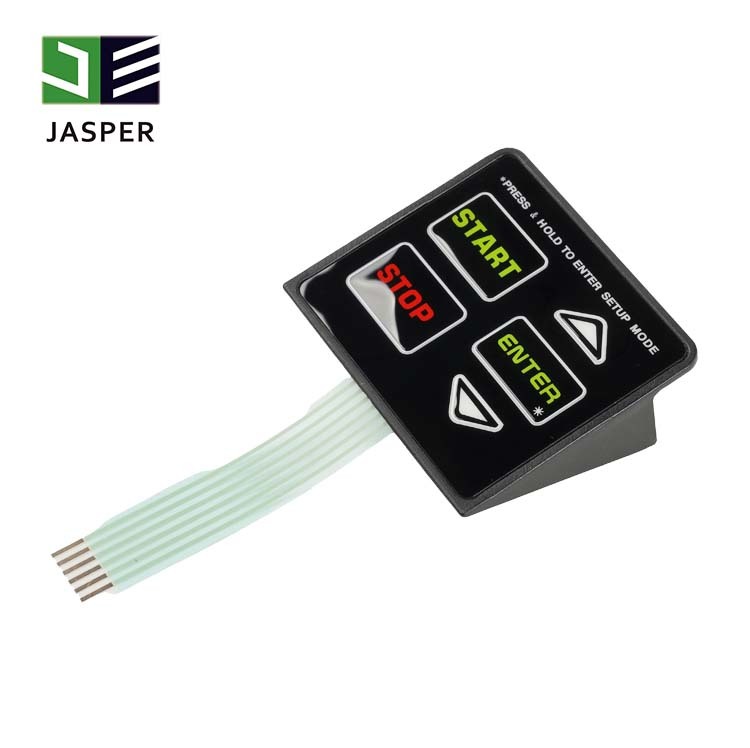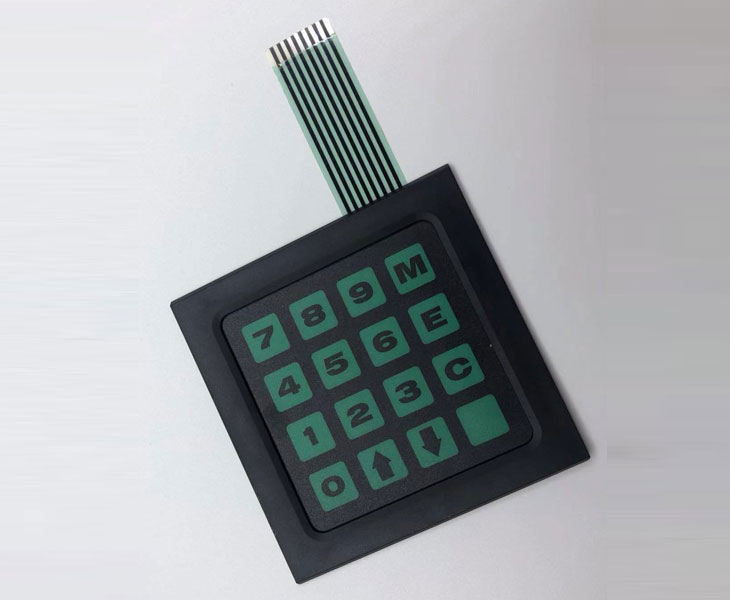How to choose the right membrane switch for your sector
The Manufacturing Refine Behind Membrane Layer Switch: What You Required to Know
The manufacturing process behind membrane switches over combines careful layout, material option, and high quality control. It starts with comprehending the intricacies of membrane layer button design and proceeds through numerous stages, including product choices and printing methods. Each phase plays an important duty in guaranteeing capability and resilience. The complexities of layer building and the rigorous testing requirements might reveal insights that are not right away noticeable. What lies beyond these fundamental elements?
Understanding Membrane Change Layout
Membrane switches may appear basic at very first glimpse, their layout includes detailed factors to consider that assure capability and durability. The design process starts with a comprehensive understanding of customer needs, consisting of the user interface's designated application and ecological aspects. Functional designs is a crucial element, as the layout must facilitate convenience of usage while making certain that responsive comments meets individual expectations.Moreover, the layering of elements, such as graphic overlays, adhesive layers, and conductive traces, must be specifically crafted. membrane switch. This layered configuration not just influences the switch's responsiveness yet additionally affects its longevity. Attention is offered to the securing techniques used to secure versus wetness and dirt, which could compromise efficiency. Furthermore, style considerations expand to aesthetics, where shade systems and visual quality improve user experience. Inevitably, the style of membrane switches over balances performance, individual experience, and resilience, ensuring that they satisfy the demands of numerous applications efficiently
Products Utilized in Membrane Layer Switch Over Manufacturing
When selecting materials for membrane layer switch manufacturing, it is important to contemplate both efficiency and toughness. The primary products consist of polyester and polycarbonate films, which give versatility and toughness. These movies are frequently covered with adhesive to ensure correct bonding to substrates. Conductive inks, commonly composed of silver or carbon, are important for creating electrical links within the switch, enabling reliable operation.Additionally, a protective layer, such as a difficult layer, is regularly put on improve scrape resistance and longevity. The option of backing product, such as acrylic or foam, can substantially impact the switch's tactile feel and general customer experience. Various environmental variables, consisting of temperature and humidity, ought to assist product option to assure peak efficiency in details applications. Ultimately, the best combination of products adds to the membrane layer button's capability and lifespan, making notified options necessary for suppliers.
The Printing Refine: Creating Video and Text
The printing procedure in membrane layer button manufacturing plays a significant role in producing top quality graphics and text. Various graphic design techniques are utilized to ensure visual appeal and functionality, while careful ink option methods are crucial for longevity and performance. Comprehending these aspects is fundamental for achieving best lead to membrane switch layout.
Graphic Design Techniques
Graphic layout methods play a vital role in the printing procedure of membrane switches, as they specify how graphics and message will eventually appear on the end product. Efficient visuals style involves the critical use of shades, designs, and typefaces to improve readability and aesthetic charm. Developers commonly utilize vector graphics for scalability, ensuring that photos remain sharp at different dimensions. Furthermore, focus to contrast and positioning is essential, as it influences user interaction and visual quality. The consolidation of branding components, such as logos, should be taken care of with care to preserve brand integrity. Generally, thoughtful visuals design methods add substantially to the functionality and appearance of membrane layer switches, influencing user experience and product efficiency.
Ink Option Approaches
Selecting the suitable ink is vital for attaining the desired visual quality and toughness in membrane layer button manufacturing. Various ink types are used, consisting of solvent-based, water-based, and UV-curable inks. Each kind offers distinct qualities, such as bond, versatility, and resistance to environmental factors. Solvent-based inks are frequently favored for their toughness and vivid shades, while water-based inks are more environmentally friendly but might have constraints in attachment. UV-curable inks give quick treating and robust performance. Additionally, shade matching strategies guarantee that the selected inks straighten with layout specifications. Ultimately, the option of ink have to take into consideration elements such as application method, substrate compatibility, and end-use needs to accomplish exceptional cause membrane button graphics and text.
Layer Construction and Assembly

Product Selection Process
A careful selection of materials is vital in the production process of membrane web layer switches, as it directly influences performance and toughness. The key products made use of consist of polyester, polycarbonate, and numerous conductive inks. Polyester is usually favored for its exceptional resistance to chemicals and abrasion, making it appropriate for extreme atmospheres. Polycarbonate, on the other hand, offers exceptional clearness and impact resistance, which is useful for applications needing presence and effectiveness. Conductive inks, typically made up of silver or carbon, are essential for producing trustworthy electrical pathways. Additionally, the selection of sticky materials influences the total stability of the switch - membrane switch. Evaluating variables such as ecological exposure, tactile responses, and aesthetic needs guides producers in selecting the very best products for their particular applications
Layer Adhesion Strategies
Adhering layers in membrane layer button building and construction is a crucial process that assures link performance and longevity. Numerous adhesion strategies are utilized to secure excellent bonding in between layers, which normally include using adhesives, warm, and stress. Pressure-sensitive adhesives (PSAs) are frequently utilized for their convenience of application and immediate bonding capacities. Furthermore, thermal bonding strategies can be used, where heat is utilized to activate sticky homes, securing a strong bond. The selection of adhesion technique mostly depends on the materials entailed and the particular application demands of the membrane layer switch. Correct alignment and uniform application of adhesives are important to protect against problems, safeguarding the switch operates successfully throughout its intended life expectancy.
Quality Assurance Measures
Ensuring top quality control during the layer construction and assembly of membrane layer buttons is important for preserving efficiency and reliability. This process typically includes a number of critical steps, including complete inspections at each stage of production. Producers use sophisticated testing approaches, such as peel examinations and adhesion evaluations, to confirm the honesty of layer bonds. In addition, aesthetic examinations are conducted to identify any defects in printing or material disparities. Environmental conditions, such as temperature and humidity, are carefully monitored to assure excellent healing and attachment. In addition, normal calibration of tools aids preserve exact manufacturing standards. By applying these top quality control procedures, makers can significantly decrease the risk of item failing, ensuring that the final membrane layer switches over satisfy the required requirements and consumer expectations.
Checking and Quality Assurance Steps

Innovations in Membrane Layer Change Technology
As advancements in modern technology remain to evolve, membrane layer switches are taking advantage of ingenious growths that improve their functionality and customer experience. One noteworthy innovation is the combination of capacitive touch technology, which enables more intuitive and receptive individual interfaces. This change not only boosts looks but likewise reduces mechanical deterioration, extending the life expectancy of the switches.Additionally, advancements in visuals overlay materials have caused improved toughness and resistance to environmental aspects such as dampness and UV light. These materials currently supply enhanced clearness and illumination, further boosting the aesthetic appeal.Furthermore, the incorporation of wise modern technology is transforming membrane switches over right into interactive control panels, allowing connection with IoT tools. This connection promotes a smooth customer experience, leading the way for applications in different markets, from medical care to consumer electronics. Collectively, these advancements placement membrane layer switches as important parts in contemporary device layout.
Frequently Asked Questions
The length of time Does the Membrane Layer Switch Over Production Refine Take?
The period of the membrane layer button production procedure can differ considerably. Factors such as complexity, materials used, and manufacturing volume influence timelines, with common production ranging from a few days to several weeks for completion.
What Are the Common Applications for Membrane Switches?
Membrane layer buttons are generally made use of in various markets, including automobile controls, home appliances, medical devices, and customer electronic devices (membrane switch). Their convenience and durability make them ideal for applications calling for straightforward user interfaces and trusted efficiency in varied atmospheres
Can Membrane Layer Changes Be Customized for Specific Demands?

What Is the Life-span of a Regular Membrane Switch?
The life expectancy of a normal membrane layer button varies, however normally, it varies from 1 to 5 million cycles. Variables such as use, setting, and worldly quality greatly influence resilience and general performance in time.

Are Membrane Switches Over Environmentally Friendly?
The ecological kindness of membrane switches differs. Some products utilized may not be recyclable, while others can be environmentally friendly. The overall influence relies on producing materials and techniques, demanding cautious consideration throughout choice and disposal. The manufacturing procedure behind membrane layer switches combines mindful style, material option, and high quality control. It begins with recognizing the ins and outs of membrane button style and progresses via different phases, consisting of material options and printing techniques. When picking materials for membrane layer switch production, it is necessary to contemplate both performance and sturdiness. A careful selection of products is important in the production process of membrane layer switches, as it straight affects performance and durability. The option of adhesion technique largely depends on the materials entailed and the particular application needs of the membrane switch.